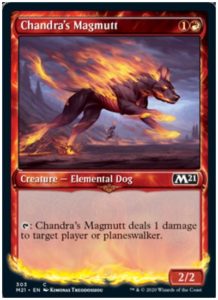

On the draw, our opponent often has at least two creatures, which means Sarkhan, Fireblood often dies immediately after rummaging once, which isn't a very good deal for three mana. On the play, we can Abrade our opponent's Turn 2 play and then follow up with Sarkhan, Fireblood on Turn 3 on an empty board, which makes it much more likely to survive the turn and allow us to start playing Dragons on Turn 4 using its mana-generating +1.

One thing we learned during our matches is that Sarkhan, Fireblood is much better on the play than on the draw. It's either the best card in our deck or does nothing. Then, we cast Dragons for the next couple of turns and hope that they are good enough to win the game, which they often are. The basic theory of the deck is simple: we kill something on Turn 2 and play a Sarkhan, Fireblood or Dragon's Hoard on Turn 3, giving us either five or six mana on Turn 4, which is enough to start casting Dragons. The most important part of the deck is our ramp spells.Meanwhile, Glorybringer is still great, offering haste damage and the ability to kill annoying creatures, while Demanding Dragon is basically a backup Glorybringer. It's more than worth the cost if we can make just a single Dragon token, and we even won a game by using its Dragon-pumping ability. Lathliss, Dragon Queen was a lot better than I expected. Even beyond the Elder Dragons, we have a bunch of other Dragons in the deck.There's some argument for playing it in the main deck, but it puts a lot of pressure on our mana, since we don't have any white lands, which means we're relying on Unclaimed Territory, Dragon's Hoard, and Sarkhan, Fireblood to cast it. Finally, Chromium, the Mutable is a great sideboard option for control matchups, but we didn't run into any true control deck in our league, so we didn't really need to bring it in. While it has solid stats, because it's a one-of, we just didn't happen to draw it in a situation where it was good. Meanwhile, Palladia-Mors, the Ruiner didn't really do much in our matches. A 6/6 flyer for six is already a fine deal, and its attack trigger was extremely helpful in getting out of some sticky situations, killing things like God-Pharaoh's Gift (and occasionally throwing massive Dragons into play from the top of our deck for free). The surprise all-star of the deck was Vaevictis Asmadi, the Dire. Not only is it powerful, but it's also only four mana, which is huge for our curve (since most of our Dragons are five and six mana).


#FIVE COLOR PLANESWALKERS MTG GOLDFISH STANDARD SERIES#
Just a quick reminder: if you enjoy the Much Abrew About Nothing series and the other video content on MTGGoldfish, make sure to subscribe to the MTGGoldfish YouTube channel to keep up on all the latest and greatest. Can the plan work in Core Set 2019 Standard? Let's get to the video and find out then, we'll talk more about the deck! What happens when you jam all of these cards together into a deck that's overflowing with powerful cards and good removal? You end up with Five-Color Elder Dragons, of course! The basic plan of our deck is simple: we kill things in the early game, hopefully ramp on Turn 3 with Sarkhan, Fireblood or Dragon's Hoard, and then spend the rest of the game casting Dragon after Dragon. Next week, we'll get back to playing Instant Deck Tech decks, I promise, but for this week, we have another special Core Set 2019 episode! One of the highlights of Core Set 2019 is a bunch of powerful Elder Dragons along with some good Dragon support cards like Sarkhan, Fireblood and Dragon's Hoard. Hello, everyone! Welcome to another episode of Much Abrew About Nothing.


 0 kommentar(er)
0 kommentar(er)
